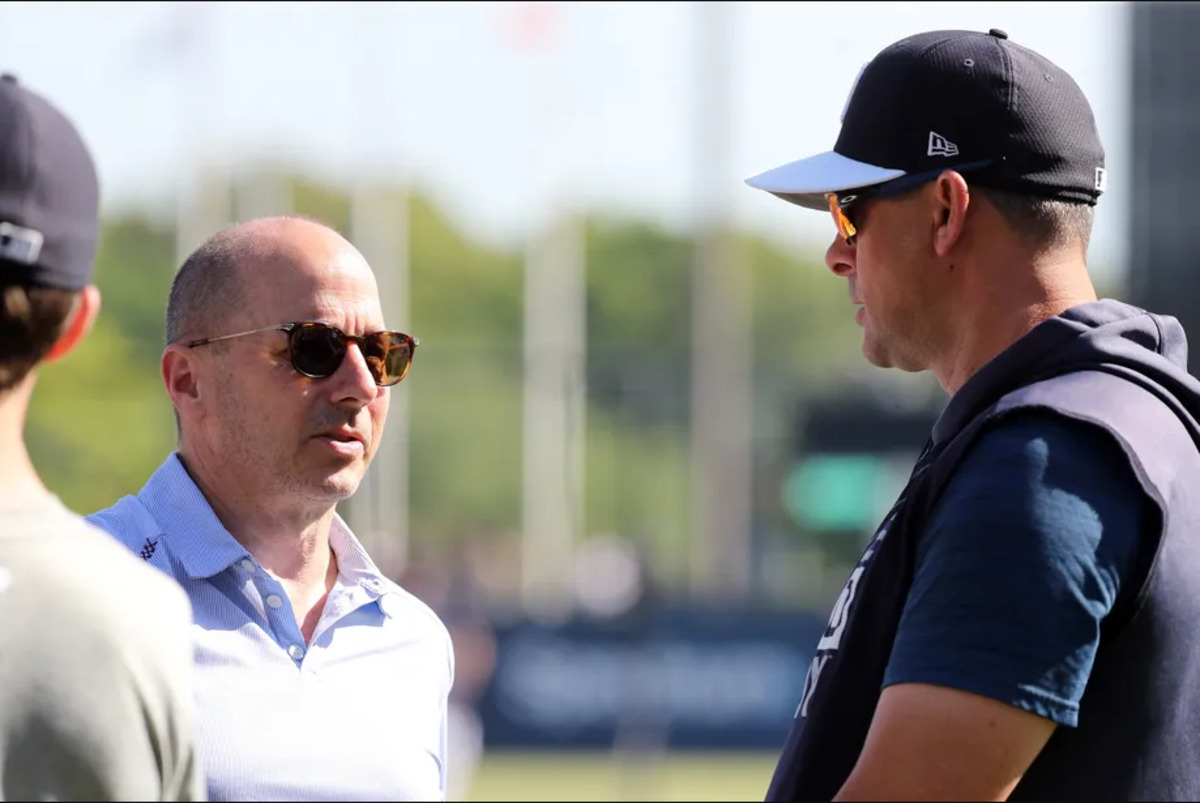New report shows Cashman lied to shield himself from mounting criticism
John Allen
More Stories By John Allen
- Mother’s Day: How Anthony Volpe’s mom molded him into a Yankee phenom
- Ben Rice demoted to Triple-A amid MLB struggles, Luis Gil begins rehab in Yankees roster moves
- Yankees’ Oswaldo Cabrera admits mistake in ninth-inning pitch clock violation: ‘It’s my fault’
- Boone confirms Anthony Rizzo’s likely Sunday activation for Yankees
- Yankees 5-6 Cardinals: Stanton’s near Grand Slam falls short as St. Louis earn first-ever win at new Yankee Stadium
- November 22, 2023
- 11:35 am
- No Comments
Table of Contents
Brian Cashman’s self-defense on November 7 is a piece of history that no Yankees fan loves to see again. According to a new report, the Yankees GM misled reporters about his analytics department that was in line of fire.
Cashman dedicated a significant portion of his self-defense to uphold the Yankees’ analytics division. He mentioned that “We actually have the smallest analytics department in the American League East.”
The Yankees GM expressed surprise that these facts were not widely known and criticized the lack of in-depth investigation behind the accusations thrown at the team for being overly reliant on analytics.
Following Cashman’s assertion that the Yankees possess the smallest analytics department in their division, Four Rings Sports Solutions, a data-centric company specializing in assisting professional sports teams in enhancing player acquisition and optimization for sustainable success, presented a chart challenging Cashman’s statement. According to the chart, dated as of August 27, 2023, the Yankees ranked as the second-largest in research and development staffing in baseball. Four Rings’ chart accounted for 43 full-time analysts and engineers, with the Rays having 44 such personnel.
While the company’s chart didn’t match Cashman’s claim, a difference in accounting methods likely factored into the discrepancy.
Report proves Cashman wrong
Approximately one week following his initial remarks, and in the aftermath of the Four Rings chart gaining traction on social platforms, Cashman was queried about his methodology for tallying the number of personnel within the Yankees’ analytics department.
Unless some AL East teams hired a bunch of people since late August, his statement is not accurate according to our research. #Yankees #MLB https://t.co/92wtOtLP3H pic.twitter.com/im4PW33Lgf
— Four Rings Sports Solutions (@FourRingsSports) November 7, 2023
Cashman mentioned on November 16, during his address at Covenant House’s annual Sleep Out event, that he relies on his analytics department to count them. He highlighted that the director provides him with this information, indicating that he isn’t aware of the methodology used by external firms to analyze the data. Consequently, he expressed difficulty in commenting on it as he hadn’t personally observed it. However, Cashman emphasized his trust in his team, stating that he values their insights over external sources.
David Grabiner serves as the Yankees’ director of quantitative analysis. In response to Cashman’s recent statement, the Daily News contacted Four Rings Sports to inquire about its methodology for compiling the data. Zack Scott, the company’s founder, CEO, and former Mets acting general manager, responded via email, providing the names of the 43 Yankees employees included in the chart as of August 27.
Scott explained that he gathered the names through his own research, primarily utilizing media guides, front office directories, team websites, and LinkedIn. While he couldn’t confirm the current employment status of all listed individuals, he expressed confidence that the majority were still with the Yankees. Scott mentioned that he typically reviews his headcounts annually but also monitors changes as they come to his attention.
He indicated that he was not aware of any other individuals or entities keeping track of similar data.

43 of Cashman’s employees are into analytics
In addition to detailing specific job titles, Scott’s compilation categorized the 43 employees into three broader roles: “leader,” “systems,” and “analyst.” The breakdown included 19 individuals with a “systems” role, primarily comprising those with “engineer” in their titles. Additionally, there were 23 individuals classified under “analyst,” with not all having explicit terms like “analyst” or “analysis” in their job titles.
Michael Fishman, a team vice president and assistant general manager, was the sole individual assigned to the “leader” role. Fishman, with an analytical background, had previously served as the club’s director of quantitative analysis.
Scott suggested that Cashman’s assertion about having the smallest analytics department in the AL East might not have factored in the “systems” personnel. Even when considering only the “analysts” and Fishman, the Yankees would have 24 analytics staff, still placing them second overall behind Tampa, which has 26.
Scott suggested that Cashman might not be including the systems people in his count. Scott believed that within the analyst group, Cashman might only be considering individuals involved in quantitative analysis, potentially overlooking those in advance scouting or other departments utilizing analytical skills. Scott pointed out the varied approaches to accounting for such personnel, expressing a preference for a broader scope due to the integration of employees with analytical backgrounds across various aspects of baseball operations.
Scott reiterated similar comments during a recent episode of the Baseball Isn’t Boring podcast. During the discussion, he mentioned, “I may define things a little differently” when conducting headcounts and emphasized his approach of including individuals with an analytical background, even if they are not officially part of a team’s analytics department.
Scott clarified that there might be individuals with backgrounds in analytics who have transitioned into roles within player development or scouting. He aimed to encompass all individuals whose skill sets and backgrounds align with analytics, regardless of their current positions. Scott suggested that there might be people not accounted for in the count conducted by highlighting the possibility of those who’ve shifted roles but still possess analytical expertise.
During the podcast, Scott also noted the Yankees‘ uniqueness in having a substantial number of employees both in New York and at their complex in Tampa. He speculated that Cashman’s assertion might have been solely based on the count of employees in New York.
Furthermore, Scott mentioned on the podcast that having 24 individuals would still position the Yankees as having the second-largest number of staff with analytical backgrounds. However, he acknowledged the point made by Cashman, emphasizing that the team possesses a deeper understanding of its department compared to external assessments.
Scott suggested that Cashman might have a lower count than himself. He highlighted the potential discrepancy that might arise if one only considered individuals with the specific title of “quantitative analyst.” Scott, however, conducted an analysis focusing on individuals working as analysts, excluding software engineers or biomechanical engineers. According to Scott’s assessment, this broader definition placed Cashman’s team as the second-highest in baseball, consisting of approximately 24 people. Scott expressed uncertainty regarding Cashman’s numbers, acknowledging that Cashman possesses greater insight into his own operation.
Scott clarified that his approach to counting personnel was based on his methodology and understanding.
Irrespective of the specific counts and rankings, the Yankees are widely recognized as a team that heavily relies on analytics. While this approach is common among successful teams, the Yankees have faced scrutiny, particularly in the wake of their 2023 season where they fell short of playoff expectations. Critics, including star players Aaron Judge and Gerrit Cole, have voiced opinions on the team’s utilization and comprehension of the vast amount of available data.

In response to such narratives, the Yankees have taken steps to address concerns this offseason. Owner Hal Steinbrenner has refuted the notion that the team’s analytics department dictates the managerial decisions made by Aaron Boone in the dugout.
Cashman has emphasized the significance of analytics within their team, likening it to an essential component in the overall functioning, stating that it holds similar importance across successful operations. He highlighted that every successful team utilizes analytics, including theirs. However, Cashman dismissed the notion that their team is solely guided by analytics as a primary driving force, labeling it as an inaccurate portrayal. He expressed frustration at the persistent narrative asserting their reliance on analytics as a falsehood, acknowledging the challenge of altering that perception. His stance remained firm in denying the characterization, emphasizing that it is not accurate.
What do you think? Leave your comment below.
- Categories: aaron judge, Hal Steinbrenner
- Tags: aaron judge, Hal Steinbrenner


 Follow Us
Follow Us









